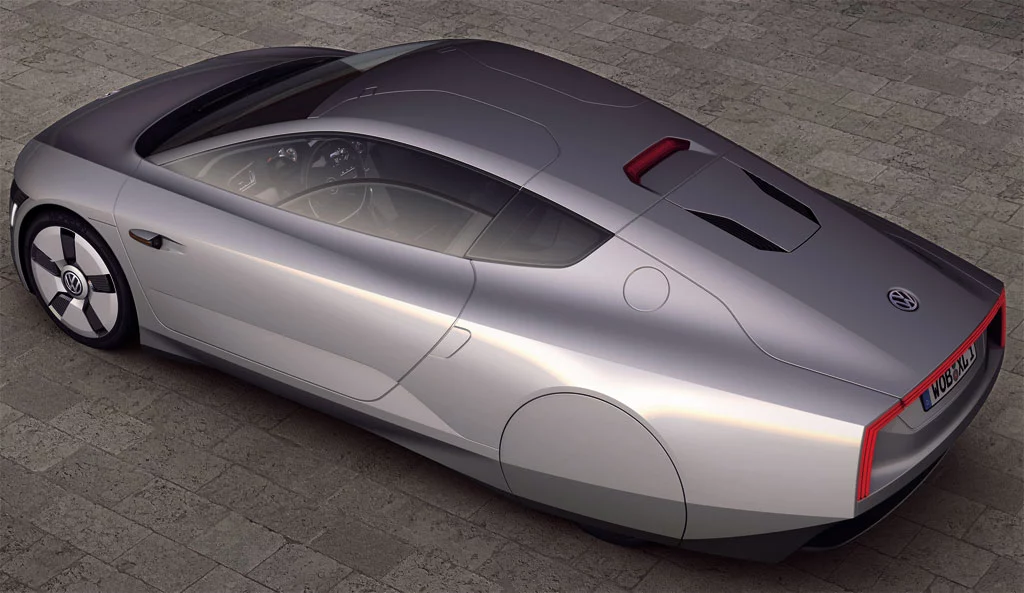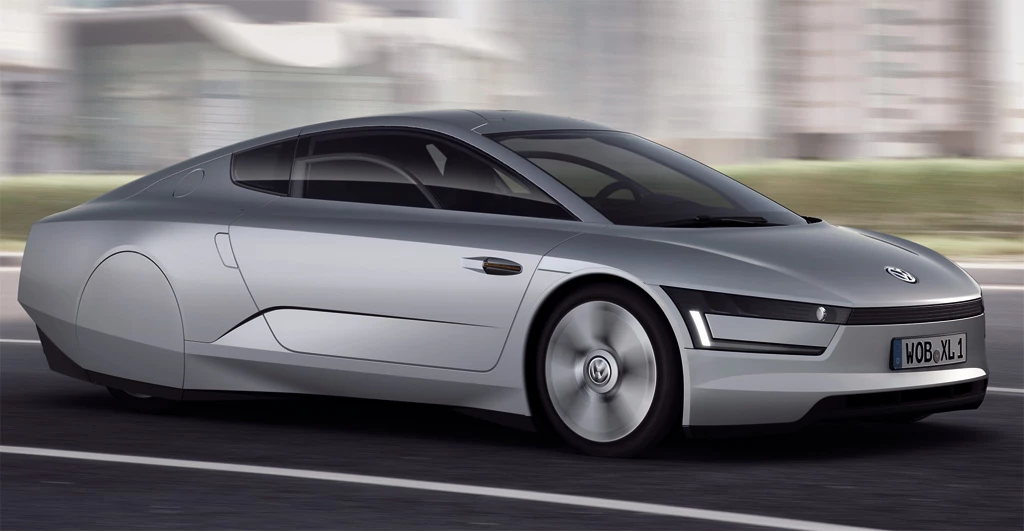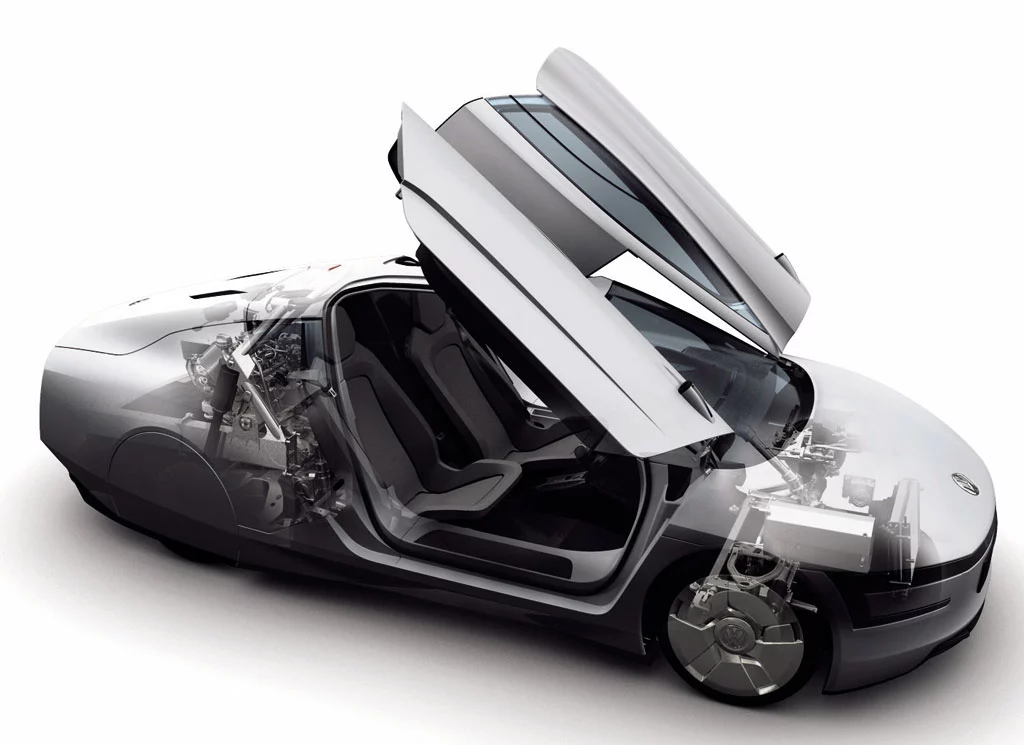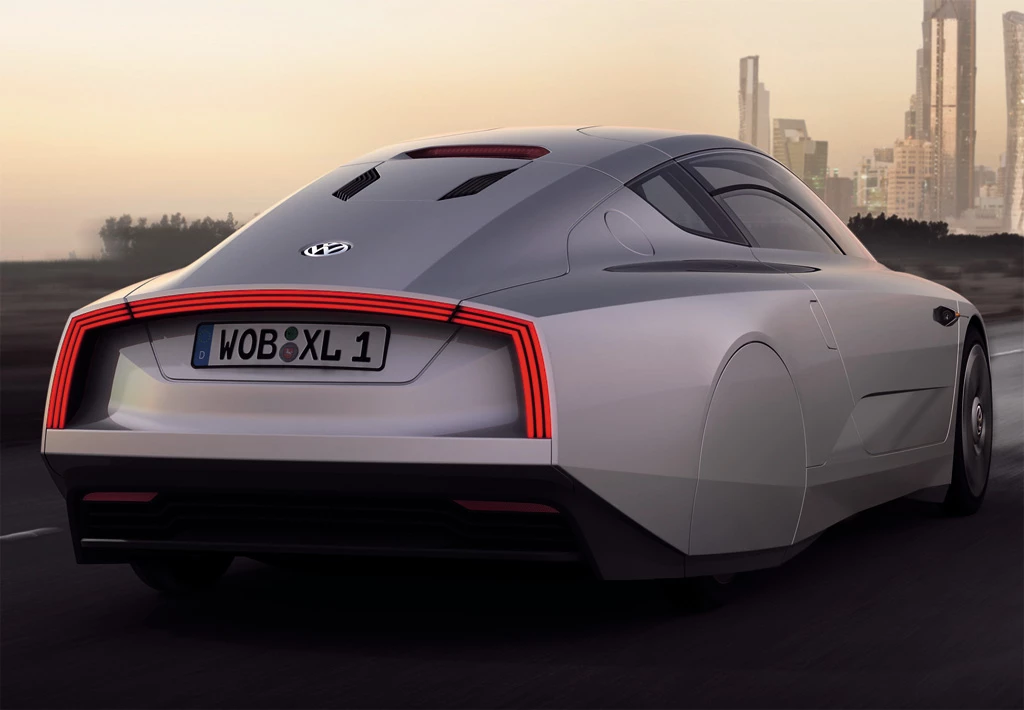At the dawn of the millennium, Prof. Dr. Ferdinand Piëch, who is today Chairman of the Supervisory Board of Volkswagen AG, set his sights on creating a practical everyday use production car with a fuel consumption of 1.0 liter per 100 km (235 mpg). In 2002 a prototype VW 1-Litre was unveiled, which was followed in 2009 by the second-generation model, dubbed the L1, which boasted a combined diesel fuel consumption figure of 1.38-liter/100 km (170 mpg). As impressive as that figure is, the company has now managed to squeeze a combined fuel consumption of just 0.9-liter/100 km (261 mpg) with its third-generation VW 1-Litre prototype – the XL1.
With a combined fuel consumption of just 0.9-liter/100 km and CO2 emissions of 24 g/km, VW is calling the XL1 is the most efficient car in the world. This is achieved through a combination of lightweight construction using monocoque and add-on parts made of carbon fiber, very low aerodynamic drag (Cd 0.186) and a plug-in hybrid system consisting of a two cylinder TDI engine (35 kW/48 PS), E-motor (20 kW/27 PS), 7-speed dual clutch transmission (DSG) and lithium ion battery.
Keeping the weight off
With a weight of just 1,753 lb (795 kg), the car also takes advantage of progresses made in Formula 1 car construction in the manufacture of body parts from carbon fiber reinforced polymer (CFRP) parts. Together with suppliers, VW has developed an patented a new system for CFRP production known as the advanced Resin Transfer Moulding (aRTM) process that has allowed the company to achieve significant reductions in production costs, which it says is an important step towards making a limited production run of the XL1 viable.

Hybrid system
With the hybrid system engaged the prototype XL1 accelerates from 0-62 mph (0-100 km/h) in 11.9 seconds and has an electronically limited top speed of 100 mph (160 km/h). The electric motor can deliver 100 Nm of torque from a standstill and works as a booster to support the TDI engine, which itself delivers 120 Nm of torque. Together, the TDI and E-motor deliver a maximum torque of 140 Nm in boosting mode.The entire hybrid unit is housed above the vehicle’s driven rear axel, with the actual hybrid module with electric motor and clutch positioned between the TDI and the 7-speed DSG. Instead of the usual flywheel, the hybrid module is integrated in the DSG transmission case. The vehicle’s lithium-ion battery can also be recharged from a conventional household outlet.
In electric only mode the TDI is decoupled from the drivetrain by disengaging a clutch, and it is shut down. Meanwhile, the clutch on the gearbox side remains closed, so the DSG is fully engaged with the electric motor. Using what is known as “pulse starting”, VW says the restarting of the TDI while driving is very smooth. The electric motor’s rotor is sped up and quickly coupled to the engine clutch, which accelerates the TDI to the required speed and starts it.
Under certain conditions the load shared between the TDI engine and the electric motor can be shifted so that the turbodiesel is operating at its optimum efficiency level. Additionally, the gears of the automatically shifting 7-speed DSG are also always selected with the aim of minimizing energy usage with the engine controller taking into account parameters such as the accelerator pedal position and engine load, as well as the energy supply and mix of kinetic and electrical energy at any given time.

Keeping it cool
The 0.8 liter two cylinder TDI used in the XL1 was derived from the 1.6 liter TDI found in the VW Golf and Passat. When required, the TDI is cooled through the activation of an externally driven electric water pump and an automatically controlled air intake system at the front of the vehicle designed to reduce cooling system drag. A second electric water pump, which is also used only as needed, circulates a separate lower temperature coolant loop to cool the starter generator and power electronics.
Design and aerodynamics
While the two seater XL1 borrows much of its looks from the preceding L1 model, it has been widened to allow for side by side seating rather than the tandem arrangement seen in both of the previous 1-Litre cars. The XL1 measures 12.75 ft (3.88m) long, 5.46 ft (1.66 m) wide and 3.79 ft (1.15 m) high, giving it a length and width similar to a VW Polo, but with a low profile comparable to a Lamborghini Gallardo Spyder. With a frontal area of 1.5 m2 and a drag coefficient of 0.186, the XL1 yields a total drag, or Cd.A value of 0.277 m2.Viewed from above, the car is widest at the front and narrows towards the rear for an improved aerodynamic profile, which VW says resembles the aerodynamic lines of a dolphin. The dolphin-like looks continue to the side profile with the roofline tracing an arc from the A-pillars to the rear.
To prevent air turbulence the rear wheels are fully covered and the air flows have also been optimized by small spoilers in front of and behind the wheels, while the door mirrors have been replaced with digital cameras that send images to two displays inside the vehicle.

Instead of the aircraft-style canopy door of the first 1-Litre and the L1, the XL1 sports wing doors that are hinged low on the A-pillars and just above the windscreen in the roof frame, so they swivel slightly forwards as well as upwards for easier access.
At the front end there’s no longer a typical radiator grille with the actual air intake with electronically controlled louvres for cooling the TDI engine, battery and interior located in the lower front end section. There are also energy-efficient dual LED headlights and narrow turn indicators.
LEDs are also prominent at the rear with a strip of red LEDs integrating reversing lights, rear lights, rear fog lights and brake lights, framing the top and sides. The coupé-shaped roofline has no rear windscreen but includes a large rear boot lid that covers the drive unit and 100-liter luggage space.

When the L1 was unveiled in 2009, Volkswagen indicated it would be entering production in 2013. We’ll be interested to see if this updated model is on track for that date or whether the company hopes to bring the XL1 into production before then. All will hopefully be revealed this week when Volkswagen unveils the XL1 at the Qatar Motor Show, which runs from January 26 to 29.





















